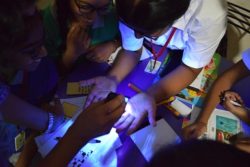Outputs and Impacts: Superheroes against Superbugs
Current findings
A formal evaluation plan was put in place to evaluate the effectiveness of the approaches used in the workshops. This included pre- and post-workshop questionnaires and key-informant interviews immediately after the workshops as well as focus group discussions and questionnaires 3 months after the workshops.
Data suggest that the workshops were effective in conveying the science behind ABR and the problems posed by it to participants.
Continued Engagement of participants with ABR post-workshops:
 In order to evaluate the post workshop engagement of participants from the government school (lower socio-economic backgrounds) with their parents, a small questionnaire in local vernacular language was given to the students to share with their respective parents after their interactions on the topic (4 months after the initial workshop).
In order to evaluate the post workshop engagement of participants from the government school (lower socio-economic backgrounds) with their parents, a small questionnaire in local vernacular language was given to the students to share with their respective parents after their interactions on the topic (4 months after the initial workshop).
Overall, the responses show that most students were able to make their parents positively understand necessary steps to be taken at individual level to prevent infections and to stop superbugs:
- All parents could correctly identify that measures like washing hands, access to safe drinking water and using toilet instead of open spaces are necessary to avoid infections.
- 86% of them indicated following doctor's prescription and/or not stopping antibiotic course half way as solutions to stop superbugs.
- 5% of parents questioned responded negatively when asked if it is ok to purchase antibiotics from a pharmacy without doctor's prescription for minor illnesses.
- Participants from private school interacted with their peers from lower grades explaining workshop learnings through their comics. Their peers then developed small plays on bacterial resistance for other students in the school. This showed that the participants were successfully able to transfer their knowledge from workshops to others, who then communicated the learnings through the medium of short plays.
One of the key Learnings from the pilot for the organisers is that different socio-economic groups would understand and relate to the issue differently and therefore, the public engagement approach and the health communication strategy should differ depending on the target audience. For example, while the government school children could relate better to the issues of hygiene and sanitation, the private school children were more interested in topics like antibiotic usage, misuse and overuse. The comics developed by these groups and the discussions during and post workshops clearly reflected this.
Outputs and Impacts
Outputs
- Educational Resources: https://superheroesagainstsuperbugs.com/lessons-activities/
- Engagement Resources: https://superheroesagainstsuperbugs.com/grassroots-comics/
Outcomes
Successfully created young champions on ABR by empowering young people and equipping them with the compelling tool of grassroots comics
Participant schools have started their own conversations on the issues of ABR and are including teaching on this issue in their school programmes.
Tangible outcomes of instant change in behaviour in participant schools: Installation of dustbins, soaps, and good hand washing practice, instruction in all toilets and cleaning the campus each week.
Impacts
Initiated the much-need dialogue on ABT among different stakeholders and participants including technologists, artists and school teachers.
By collaborating with research institutes, SaS is encouraging researchers to get involved in societal discourse on ABR.
Reaching out to different sections of society on ABR through children.
Approach garnered interest from educational institutions and research community alike, helping to build partnerships to ensure sustainability of the project beyond the pilot.
